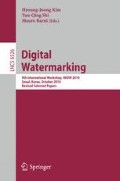Abstract
A method is described to prevent video images and videos displayed on screens from being re-shot by digital cameras and camcorders. Conventional methods using digital watermarking for re-shooting prevention embed content IDs into images and videos, and they help to identify the place and time where the actual content was shot. However, these methods do not actually prevent digital content from being re-shot by camcorders. We developed countermeasures to stop re-shooting by exploiting the differences between the sensory characteristics of humans and devices. The countermeasures require no additional functions to use-side devices. It uses infrared light (IR) to corrupt the content recorded by CCD or CMOS devices. In this way, re-shot content will be unusable. To validate the method, we developed a prototype system and implemented it on a 100-inch cinema screen. Experimental evaluations showed that the method effectively prevents re-shooting.
Access this chapter
Tax calculation will be finalised at checkout
Purchases are for personal use only
Preview
Unable to display preview. Download preview PDF.
References
The Motion Picture Association of America (MPAA), http://www.mpaa.org/piracy.asp
Haitsma, J., Kaler, T.: A Watermarking Scheme for Digital Cinema. In: Proc. International Conference on Image Processing, vol. 2, pp. 487–489 (2001)
Gohshi, S., Nakamura, H., Ito, H., Fujii, R., Suzuki, M., Takai, S., Tani, Y.: A New Watermark Surviving After Re-shooting the Images Displayed on a Screen. In: Khosla, R., Howlett, R.J., Jain, L.C. (eds.) KES 2005. LNCS (LNAI), vol. 3682, pp. 1099–1107. Springer, Heidelberg (2005)
Haruyuki, N., Seiichi, G., Ryosuke, F., Hiroshi, I., Mitsuyoshi, S., Shigenori, T., Yukari, T.: A Digital Watermark that Survives after Re-shooting the Images Displayed on a CRT Screen. Journal of the Institute of Image Information and Television Engineers 60(11), 1778–1788 (2006)
Nakashima, Y., Tachibana, R., Babaguchi, N.: Watermarked Movie Soundtrack Finds the Position of the Camcorder in Theater. IEEE Transactions on Multimedia 11(3), 443–454 (2009)
Schanda, J.: Colorimetry: understanding the CIE system, Wiley-Interscience, New York (2007)
BITRAN (CCD Spectral Response), https://www.bitran.co.jp/ccd/character/
Gonzalez, R.C., Woods, R.E.: Digital Image Processing, 3rd edn. Prentice-Hall, Englewood Cliffs (2007)
Holst, G.C., Lomheim, T.S.: CMOS/CCD Sensors and Camera Systems. Society of Photo Optical (2007)
Halstead, W.C.: A note on the Bartley effect in the estimation of equivalent brightness. Journal of Experimental Psychology 28(6), 524–528 (1941)
ITU Radiocommunication Sector (ITU-R), http://www.itu.int/ITU-R/index.asp?category=information&rlink=rhome&lang=en
ITU Telecommunication Standardization Sector (ITU-T), http://www.itu.int/ITU-T/index.html
Rec. ITU-R BT.500-11: Methodology for the subjective assessment of the quality of television picture (2002)
The Institute of Image Information and Television Engineers: Evaluation video sample (standard definition)
Author information
Authors and Affiliations
Editor information
Editors and Affiliations
Rights and permissions
Copyright information
© 2011 Springer-Verlag Berlin Heidelberg
About this paper
Cite this paper
Yamada, T., Gohshi, S., Echizen, I. (2011). IR Hiding: A Method to Prevent Video Re-shooting by Exploiting Differences between Human Perceptions and Recording Device Characteristics. In: Kim, HJ., Shi, Y.Q., Barni, M. (eds) Digital Watermarking. IWDW 2010. Lecture Notes in Computer Science, vol 6526. Springer, Berlin, Heidelberg. https://doi.org/10.1007/978-3-642-18405-5_23
Download citation
DOI: https://doi.org/10.1007/978-3-642-18405-5_23
Publisher Name: Springer, Berlin, Heidelberg
Print ISBN: 978-3-642-18404-8
Online ISBN: 978-3-642-18405-5
eBook Packages: Computer ScienceComputer Science (R0)

